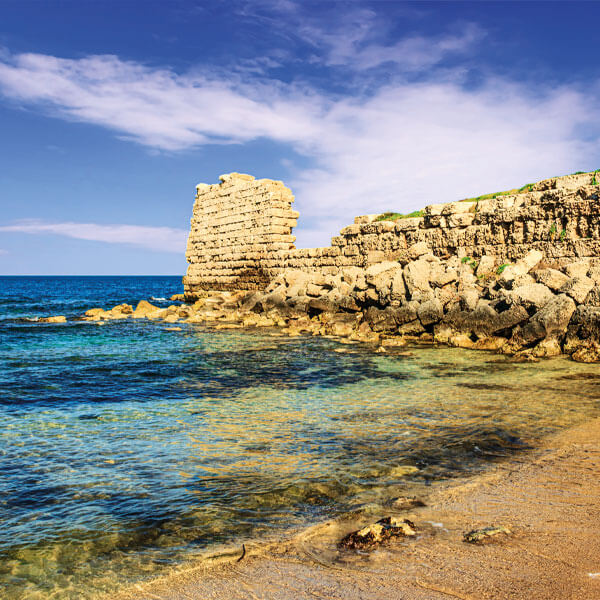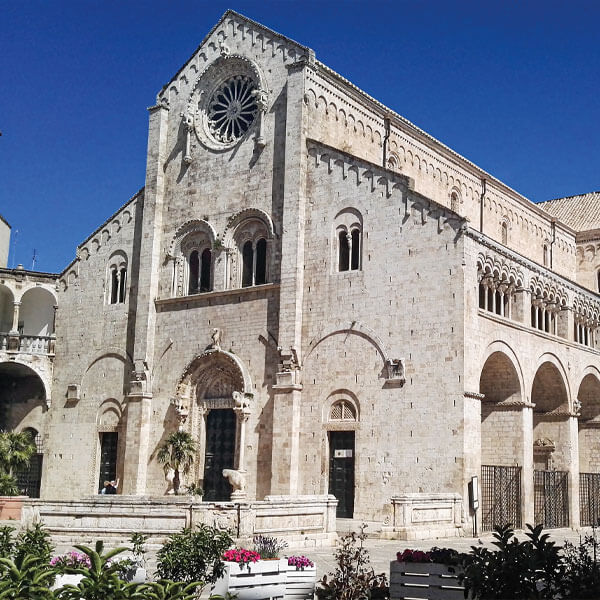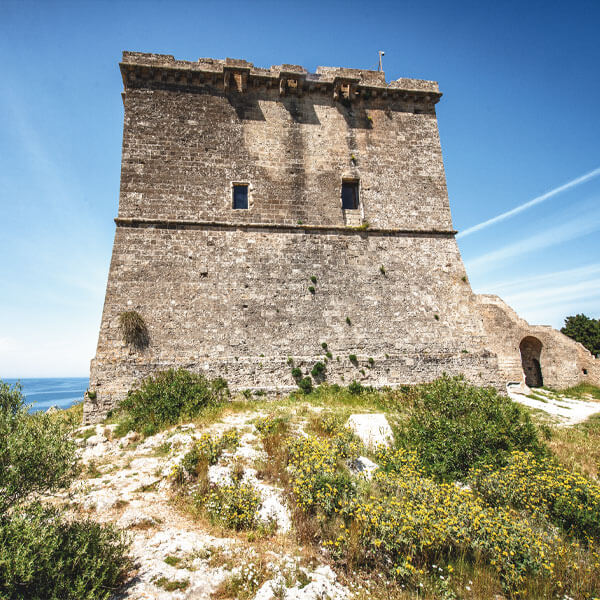On the coast near Fasano, the Archaeological Park of Egnazia showcases the ruins of Gnathia, an ancient Messapian and Roman city. Parts of the city walls and necropolis remain from the Messapian age while panels describe the layout of its Roman-era buildings. Artefacts unearthed on the site are on display in a small museum. To explore further you’ll need a swimming costume and snorkel – the ruins of the port and acropolis lie on the seabed just off the small beach.

Contemporary art goes hand in hand with classical architecture at the Archaeological Park of Siponto near Manfredonia. The park showcases the scarce remains of Siponto, an ancient Roman port and important medieval religious centre. Dominating the site is the Romanesque Basilica of Santa Maria Maggiore and artist Edoardo Tresoldi’s clever installation. This, set over the ruins of a paleochristian basilica, recreates the church’s original form in wire mesh.
The ravines that carve up the province of Taranto are home to a series of atmospheric chiese rupestri (rock churches). Particularly impressive are the medieval churches that lie hidden in the rocky landscape around Massafra and Mottola. Guided tours take in these cavernous chiese, the best of which feature wonderful Byzantine-style frescoes. For some especially striking artwork search out the Church of San Nicola near Mottola.
From the iconic Castel del Monte to the Norman castle of Deliceto, Puglia is awash with medieval forts and castles. Built by the region’s Norman, Swabian and Aragonese rulers, these remain landmark sights to this day. Bari and Taranto both boast formidable castles as do several of the region’s smaller towns, including Conversano, Gioia del Colle and UNESCO-listed Monte Sant’Angelo.

You don’t need to be an architect to appreciate the stark beauty of Puglia’s Romanesque cathedrals. Most of these date to the 11th and 12th centuries when they were built as part of an ecclesiastical drive to impose the authority of the Roman Church. The result of this medieval building boom was a string of magnificent Romanesque churches, including the Basilica of San Nicola in Bari and the cathedrals of Trani, Bitonto, Ruvo di Puglia, Molfetta and Troia.
Baroque architecture found fertile soil in Puglia when it swept into the region in the 17th century. It flourished in towns like Martina Franca, Francavilla Fontana and Nardò. However, it was in Lecce that it reached new heights, as barocco leccese gave rise to a series of monumental churches and palazzos. Buildings such as the Basilica of Santa Croce and the Duomo embody the style in all its exuberant glory.
An elegant coastal town best known for its seafront cathedral, Trani has a fascinating Jewish history. In the heart of the historic centre, you’ll find two synagogues, the Synagogue Scolanova and the Synagogue of Sant’Anna. This latter houses a small museum charting the history of the town’s Jewish community, from its origins as a group of exiles from Muslim Spain to its forced expulsion in 1510.
It’s a long way from the North Pole but Bari is the last resting place of the saint the world reinvented as Santa Claus. The relics of St. Nicholas were brought from Turkey in 1087 and have been housed in the Basilica of San Nicola ever since. Bari’s great signature cathedral also plays a starring role in the events held to celebrate the saint’s feast day on 6 December. These kick off with a special dawn mass which draws crowds of devoted locals despite the early 5am start.

Travel Puglia’s lengthy coastline and you’ll notice that many cliffs and beach fronts are guarded by stubby watchtowers (such as Torre Santa Maria dell’Alto near Nardò). These were constructed between the 11th and 16th centuries to warn against enemy attacks, first by Saracen pirates, then by Turkish invaders. They eventually fell into disuse in the 18th century. Since then, villages have grown up around some, while others have been used to house small museums. Many simply stand as landmarks.
Away from the tourist spotlight, Puglia harbours many historic and architectural gems. Two striking examples, managed by the FAI (the Italian National Trust; www. fondoambiente.it), are the Abbey of Santa Maria di Cerrate and the Abbey of SS Trinità di Monte Sacro. The first, 7 km from Squinzano, is a restored Norman abbey featuring fine Byzantine frescoes and a 13th-century loggia. The second, a ruined 11th-century monastic complex near Mattinata, enjoys an atmospheric location on Monte Sacro and can only be reached on foot.
A distinct feature of Puglia’s rural landscape are the grey drystone walls that snake across the stony countryside. The techniques used to construct these, the same as those used in the trulli of the Itria Valley, have long been passed down from one generation to the next. In 2018 UNESCO added ‘the art of dry walling’ to its list of customs, arts, events and practices that collectively comprise the ‘Intangible Cultural Heritage of Humanity’.


BuyPuglia is the digital system tailored to suit your tourism business in Puglia. Our matching platform is an easy tool to explore meeting opportunities with Puglian suppliers and learn about their tourism &.. cultural products. BuyPuglia ranks buyers and sellers based on entered information. Shared interests are paired, helping plan effective meetings and delivering optimized supply &.. demand solutions.